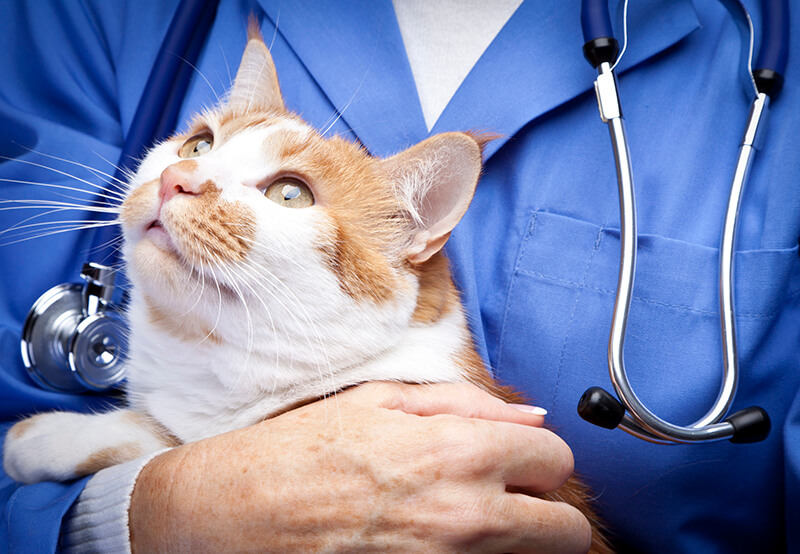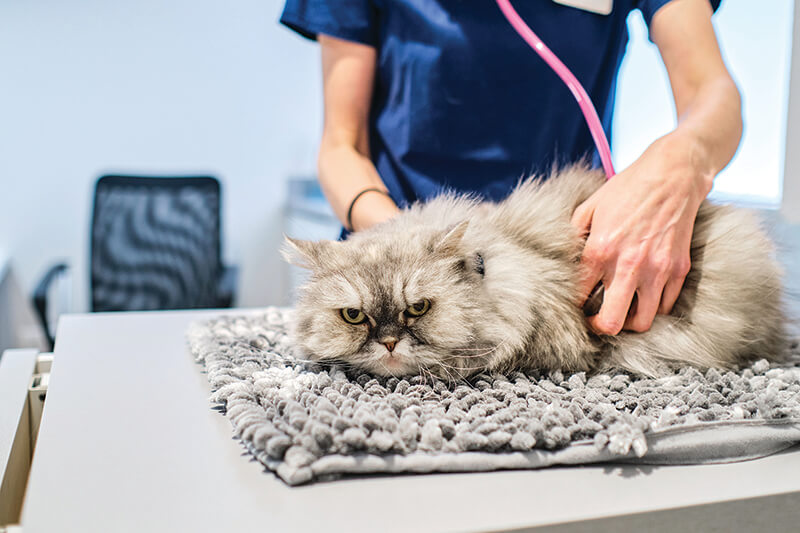
Simple, Affordable Measures to Prevent Future Health Concerns for Your Pet
Why is Preventative Pet Care Important?
We all know pets are part of the family, which is why we want to keep them living their best lives. Nobody likes to see a member of the family, human or animal, ill or in pain. How can you make a difference in your pet’s overall health and happiness? Instead of waiting for an emergency to evaluate your pet’s health, use preventative care visits to stay ahead of health problems. Routine preventative health care measures will help maintain your pet’s health, and can be an important factor in ensuring they live a long, happy, and healthy life.
Staying on top of preventative care will also be a more affordable option in the long run; by paying smaller amounts to keep your pet healthy you can avoid larger expenses for emergency care. Although you may already know it is a good idea to stay on top of preventative healthcare for your pets, you may not know exactly what that looks like. What are the most important parts of preventative care to prioritize? Read on, and we’ll provide you with a solid list to learn more about what types of preventative care measures will help decrease pain and ailments for your pet, and also stave off extra costs and heartache for you and your family.
Spay or Neuter Your Pet

When you bring home a dog or cat, it’s very important to their long-term health to prioritize spaying or neutering. Spaying, which is for female cats and dogs, and neutering, which is the procedure for male cats and dogs, will have more benefits than just the avoidance of an expected litter of puppies or kittens.
Female animals who are spayed (which means removing the female reproductive organs) have a reduced risk of uterine infections, breast cancer, and mammary tumors, according to Life Line Animal. Notably, intact female dogs and cats have an increased risk of developing pyometra, a life-threatening infection of the uterus that requires immediate invasive surgery. According to the American College of Veterinary surgeons, pyometra can be very expensive to treat. However, if it is not treated on time, the infection can cause blood poisoning, peritonitis, kidney failure, or even death. For male dogs and cats, neutering significantly reduces the risk of testicular cancer. According to the Humane Society of the United States, neutering male pets also eliminates the risk of developing prostatic hyperplasia, which can affect your pet’s ability to defecate.
In addition to helping pets avoid painful ailments like certain cancers, spaying and neutering can also protect them from other types of injuries or pains. Dogs and cats who have been spayed or neutered will be far less likely to roam or fight. This decreases the chance that your pet will receive fight-related injuries, including nasty viruses that can be spread through bite wounds. Spaying and neutering also lowers the natural aggression of animals, which means your pet will be less likely to have conflicts with other animals or humans. When you and your family are training and getting to know your pet as a new member of the family, spaying and neutering can help keep everyone feel safe and comfortable. And, according to the Humane Society of the United States, pets who are spayed or neutered typically experience a longer life expectancy. To keep your pet healthy and around for longer, and to keep other members of your family safe as well, spaying and neutering is the way to go.
Take Your Pet to Annual Checkups

It may sound simple, but when life gets busy, it can be easy to forget to stay on a regular checkup schedule with pets. However, one of the best ways to make sure your pet is doing well overall is to have a veterinary healthcare provider evaluate them on a regular basis. There may be slight changes in their health or abnormalities that an untrained eye would not spot.
When you keep your pet on a routine schedule for annual checkups, the veterinarian will get to know you and your pet better, and your pet will be able to adjust and become more comfortable with the environment of the veterinary clinic. Before attending your appointment, do a quick analysis of any problems you may want to address with your veterinarian. You can even jot down a quick note of questions you may have, regular mealtimes and food amounts for your pet, and other details that the vet is likely to ask about.
Consider thinking about these questions a week or so before the checkup:
- How is my pet’s weight? Have I noticed them becoming significantly heavier or lighter lately?
- What are my pet’s energy levels like? Do they lay around for most of the day? Do they seem to have enough energy to walk and play? Or do they have so much energy that they are destructive?
- How does my pet behave with other animals?
- How does my pet behave with humans?
- What brand of food am I serving my pet? What are the ingredients in this brand?
- What portion sizes do I serve and what times of day do I feed my pet?
Don’t be afraid to engage in an open and honest dialogue with your vet. You are an advocate for your pet who, despite their many wonderful qualities, will not be able to directly communicate with the veterinarian. Remember, no one else spends more time with your pet than you do, so you should bring up any details that you think may even be slightly important.
At the checkup, consider asking these questions if you’re not prompted first by the veterinarian:
- Are there any vaccines my pet still needs?
- Is my pet’s behavior appropriate for their age and breed?
- How do my pet’s teeth look?
- Is there anything in particular I should be doing for my pet that I’m not doing now?
- And, of course, ask any questions that are specific to your personal observations about your pet’s behavior and appearance.
Take Care of Your Pet’s Teeth
Having good dental hygiene is a huge part of having strong overall health, As beneficial as it would be to keep your pet’s pearly whites shining, oftentimes owners neglect their pet’s oral hygiene. Luckily, there are a few simple ways to make a big difference in their dental health. 
- Brush your pet’s teeth: Yes, like humans, brushing is the first step in good oral hygiene for cats and dogs. It’s ideal to brush dogs’ teeth daily, according to the American Kennel Club, but if that doesn’t sound reasonable given your schedule, even brushing once a week is a big improvement over never brushing. Make sure to use a toothpaste that is specifically designed for dogs. Fluoride, found in human toothpaste, can be harmful to animals. You should also use a toothbrush with soft bristles, specifically designed for pets.
- Schedule professional cleanings: Your vet can do a thorough cleaning, including examining your pet’s teeth, providing a polish and removing any buildup of tartar or plaque. Professional cleanings are vital, as they can help ward off serious illnesses in your pet that can begin with poor oral hygiene, including cardiovascular and maxillofacial diseases, according to the World Small Animal Veterinary Association Global Dental Guidelines.
- Dental treats: Yes, it’s not too good to be true. Dental treats can provide some dental benefits for dogs. Sometimes a dental treat can simply improve your pet’s breath, which can provide great benefit for everyone in the family. As with all treats, moderation is key, and dental treats should be viewed as a bonus benefit to your pet’s oral hygiene, not as the main solution.
Prevent Parasite Infections
The most internal common parasites for dogs include heartworm, tapeworms, hookworms, giardia, and roundworms. Your veterinarian will recommend parasite testing for any new pet in your home. The results of that testing will guide any needed treatment. Common external parasites include ticks, fleas and mites, which your vet will be able to see and diagnose. A monthly internal and external parasite medication is an essential, on-going preventative care routine that your dog will need to remain free of parasites. 
The most common internal parasites for cats include roundworms, hookworms, tapeworms, whipworms, and giardia. External parasites for cats are the same as dogs: fleas, ticks and mites. As with dogs, your veterinarian will recommend treatment for any existing parasite infections, and a monthly preventative maintenance plan to avoid future infections.
Evaluate Unique Risks for Your Pet
Discuss with your veterinarian any unique risks that may affect your pet based on where you live or your pet’s breed. Your veterinarian will be knowledgeable about the specific health vulnerabilities that are associated with certain dog and cat breeds, and also the health impact of certain types of climates. 
- Two examples of breed-based risks:
- Hip dysplasia – Certain breeds of dogs are more likely to have hip dysplasia. Your veterinarian can recommend diagnostic tools, such as an X-ray, to determine if your dog has the precursors of this condition.
- Skin conditions – Some breeds of cats and dogs are prone to skin conditions and allergic sensitivities. Your vet can advise on preventative care that will help keep these issues from erupting.
- Two examples of location-based risks:
- Extreme heat and cold – If your area experiences extreme heat or cold, discuss preventative care with your veterinarian. For example, dogs in very cold and wintery climates may benefit from paw protection before extended jaunts outdoors. Your vet can advise you on the best methods to avoid cracked and painful paw pads.
- Lyme disease – Certain parts of the United States have ticks that carry Lyme disease. Lyme disease can cause lameness, fatigue, loss of appetite and kidney damage. Lyme disease can be particularly prevalent in Lancaster, Pennsylvania whenever there is a mild winter. For winter weather to reduce tick populations, temperatures need to be consistently below 10 degrees Fahrenheit for a sustained number of days. To avoid Lyme disease:
- Avoid areas, like thick forests and tall grasses, where ticks will be prevalent.
- Check for ticks on your pet and yourself after being outside. If your pet has thick fur, you can gently comb through their coat to be thorough.
- Get the Lyme vaccine for your pets.
Stay Up to Date on Vaccines
Speaking of vaccines, one of the most important components of preventative healthcare is to ensure your pet is up to date on the vaccines they should be receiving.
When you have an appointment with your veterinarian, they will give you guidelines for vaccine requirements and timelines. Your veterinarian will likely discuss with you two categories of vaccines for your pet: core and non-core vaccines. Core vaccines are recommended for most dogs and cats, while non-core vaccines may be administered more in accordance with your pet’s lifestyle. 
For your reference as a pet owner, below is a list of the core vaccines expected for dogs and cats, according to a chart by WebMD. Core Vaccines for Dogs:
- Rabies 1-year
- Rabies 3-year
- Distemper
- Parvovirus
- Adenovirus, type 1 (CAV-1, canine hepatitis)
- Adenovirus, type 2 (CAV-2, kennel cough)
Non-Core Vaccines for Dogs:
- Parainfluenza
- Bordetella bronchiseptica (kennel cough)
- Lyme Disease
- Leptospirosis
- Canine influenza
Core Vaccines for Cats:
- Rabies
- Feline distemper (Panleukopenia)
- Feline Herpesvirus
- Calicivirus
Non-Core Cat Vaccines:
- Feline Leukemia Virus (FeLV)
- Bordetella
Vet Services for Emergencies
Of course, all the preparation and preventative health care efforts in the world do not mean that a pet is completely immune from a health scare or emergency. Emergencies can happen at any time, which is why Furdunkin offers emergency veterinary care at an affordable price. Our veterinarians, who are trained for emergency responses, will diagnose and treat your pet promptly, so they can be back to their usual activities as quickly as possible. 
We also know that health emergencies can happen anywhere unexpectedly, which is why we offer mobile vet services, our veterinary hospital on wheels, including convenient curbside service and a surgical suite for surgery or dentistry emergencies. Particularly for older pets and those who struggle with mobility, our mobile services are a convenient option. Furdunkin will bring the care right to you. Before you need any emergency services, be sure you’ve taken care of all the preventative measures possible. When you take the extra steps to improve your pet’s health, you’ll find your peace of mind and confidence in pet care will grow. Everyone’s health and happiness receives a boost when your family pet is feeling social, happy, and healthy enough to play and cuddle.
TL;DR: Keep Your Pets Healthy and Happy with Preventative Health Care
Taking preventative health measures with pets, such as having them spayed or neutered, taking them to annual checkups, controlling parasites, staying on top of their vaccines, and improving their oral hygiene, will prolong lifespans, decrease emergency health crises, and keep your pet happy and healthy.
